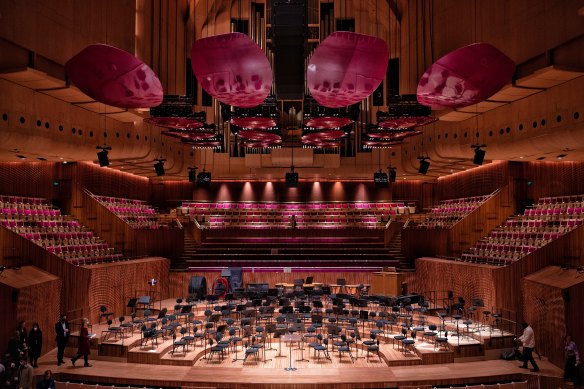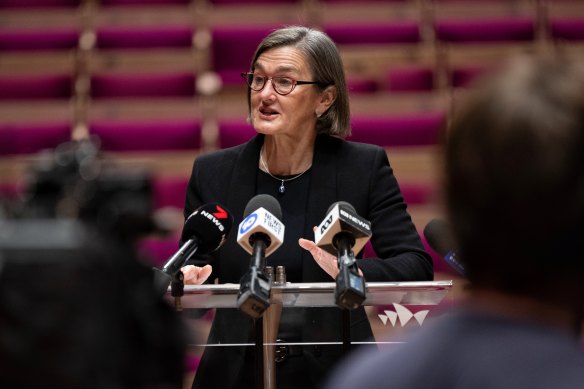This was published 2 years ago
Sydney Opera House lifts curtain on newly renovated Concert Hall
By Helen Pitt
After two and a half years, 2500 workers and a worldwide pandemic that held up work by five months, the Sydney Opera House has revealed the $150 million final renovations of its largest performance space, the Concert Hall, which reopens next week.
On the first walk-through early on Thursday, the major works of the largest and final project in the Opera House’s Decade of Renewal were unveiled – a 10-year program of capital works totalling almost $300 million.

The Sydney Opera House on Thursday revealed the $150 million final renovations of its largest performance space, the Concert Hall, which reopens next week.Credit: Nick Moir
The magenta coloured seats remain, but the once beloved clear acrylic “doughnut” sound reflectors are gone, replaced by 18 new acoustic reflectors above the stage.
These “acoustic petals” are set in a range of positions, depending on the music being played.
They have been finished in a semi-gloss magenta – matching the colour of the seats chosen by Australian architect Peter Hall.
He took over completing the interiors of the building when the Danish designer Jorn Utzon departed in 1966.

Opera House chief executive Louise Herron at the unveiling of the refurbished Concert Hall on Thursday.Credit: Nick Moir
The upgrade of the World Heritage masterpiece, ahead of its 50th anniversary in 2023, includes respect for heritage with cutting-edge technological innovations.
It includes state-of-the-art theatre machinery and staging systems that experts claim better equip the hall in presenting a range of performances, from classical music to contemporary concerts and theatre. Texture box fronts made of boxbrush wood, either side of the stage have been added to improve the sound quality.
Opera House chief executive Louise Herron said the project had improved the acoustics for artists and audiences in both orchestral and amplified mode, enhanced access for people with mobility needs and provided a more flexible and safer working environment for staff behind the scenes.
“You can feel the clarity and warmth now in both amplified and symphonic mode; the range of sound is much clearer now,” Herron said.
“I was blown away when I first heard it.”
A new lift and passageway improve accessibility, making it possible for wheelchair users and people with limited mobility to access all levels of the hall independently.
The opening concert, a performance of Gustav Mahler’s Symphony No.2, the Resurrection Symphony, will take place next Wednesday under the helm of the Sydney Symphony Orchestra’s Simone Young. Didgeridoo player William Barton will play his composition Of the Earth, accompanied by performers with 60 pairs of clapsticks made using brushbox timber salvaged from the Concert Hall’s old and new stages.
Given that half of the Opera House’s revenue comes from international tourists, Herron is hoping the reopening will be a boon for the house, which has had its revenue cut by 73 per cent since the COVID pandemic.
“This Concert Hall is ready now for the next generation and the next 50 years,” she said.
Since the venue closed for renovations in February 2020, hundreds of construction workers, acousticians, and architecture and heritage experts have been busy delivering the biggest upgrade to the Concert Hall since it opened almost 50 years ago, with all possible care and attention taken to protect and respect the heritage of this treasured performance space.
The Concert Hall is one of the largest – with 2600 seats – and longest – at 45 metres – performing arts halls in the world. It reaches 25 metres from the stage to the crown above. Perfecting the sound quality for both acoustic and amplified performances across this space was a highly technical challenge for acousticians.
At Thursday’s walk-through, NSW Minister for the Arts Ben Franklin said, “The Concert Hall is the beating heart of the Opera House.
“The renovation is a technical triumph, it will make it one of the greatest concert halls of the world.”
Fact box
- The builders installed 174 tonnes of new structural steel (equal to more than 100 cars) and 70 tonnes of new reinforcing steel.
- A quarter of the new structural steel was coated in hot pink paint to distinguish it from the primary steel that holds up the building.
- The new stage risers have a total weight of 95 tonnes (550 kilograms per square metre).
- During construction, the builders erected almost 45 tonnes of birdcage scaffolding in the auditorium to reach the ceiling.
- More than 9000 square metres (equal to about 14 tennis courts) of protection was installed across the Concert Hall and its surrounds to safeguard the heritage finishes.
- More than 91 per cent of demolition waste was recycled, well above the target of 80 per cent.
A cultural guide to going out and loving your city. Sign up to our Culture Fix newsletter here.